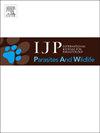Widespread geographic distribution of filarioid nematodes in caribou (Rangifer tarandus sspp.) in Canada
IF 2
3区 医学
Q3 ECOLOGY
International Journal for Parasitology-Parasites and Wildlife
Pub Date : 2024-12-07
DOI:10.1016/j.ijppaw.2024.101030
引用次数: 0
Abstract
The caribou (Rangifer tarandus sspp.) is a keystone wildlife species in northern ecosystems that plays a central role in the culture, spirituality and food security of Indigenous People. The Arctic is currently experiencing an unprecedented rate of climate change, including warming temperatures and altered patterns of precipitation. These environmental changes can facilitate the transmission of arthropod-borne parasites, such as filarioid nematodes.
Filarioids are an important cause of morbidity and occasional mortality in Rangifer in Fennoscandia, however, much of the ecology and epidemiology of these parasites in caribou in North America, including Canada, remains unknown. We aimed to determine the parasitic diversity and geographic distribution of filarioid nematodes in three Canadian designatable units (DU) of caribou (barren-ground, boreal and Dolphin & Union) from Northwest Territories, Nunavut and Newfoundland & Labrador. Genomic DNA extracted from 768 blood samples was screened for filarioid nematodes using real-time PCR. The positive samples were Sanger sequenced to identify the parasite present. Based on the sequencing results, we identified Setaria yehi and Onchocerca cervipedis s.l. We then standardized a TaqMan probe based duplex droplet digital PCR (ddPCR) protocol for the simultaneous detection of S. yehi and O. cervipedis s.l. Based on real-time PCR results, 8/768 samples were positive. Setaria yehi and O. cervipedis s.l. were present in 4 separate samples (0.5%) each. Using ddPCR, 68/192 samples were positive (35.4%). Setaria yehi DNA was detected in 57/192 positive samples (29.7%), O. cervipedis s.l. DNA was present in 22/192 samples (11.5%) and 11/192 samples (5.7%) had co-infections. Setaria yehi was detected in all three DUs tested. Onchocerca cervipedis s.l. were found in barren-ground and boreal caribou, but not from the Dolphin and Union caribou.
Through this broad-based survey and through developing and implementing advanced molecular methodologies, we have documented the apparent distribution and diversity of S. yehi and O. cervipedis s.l. in parts of three Canadian DUs of caribou. The knowledge gained from this study provides baseline data and methodology for the further elucidation of the epidemiology of these parasites in North America.

加拿大北美驯鹿(Rangifer tarandus sspp.)丝状线虫的广泛地理分布。
北美驯鹿(Rangifer tarandus sspp.)是北方生态系统中的重要野生动物物种,在土著人民的文化、精神和粮食安全中发挥着核心作用。北极目前正经历着前所未有的气候变化速度,包括气温变暖和降水模式的改变。这些环境变化可以促进节肢动物传播的寄生虫,如丝状线虫的传播。丝状虫是芬诺斯坎迪亚地区野生动物发病和偶尔死亡的重要原因,然而,包括加拿大在内的北美驯鹿中这些寄生虫的生态学和流行病学仍然未知。我们旨在确定来自西北地区、努纳武特和纽芬兰和拉布拉多的三个加拿大指定单位(DU)驯鹿(荒地、北方和海豚和联盟)的丝状线虫的寄生虫多样性和地理分布。从768份血样中提取基因组DNA,采用实时荧光定量PCR技术筛选丝状线虫。对阳性样本进行桑格测序以鉴定存在的寄生虫。根据测序结果,鉴定出叶尾丝虫病和宫颈盘尾丝虫病,并标准化了基于TaqMan探针的双液滴数字PCR (ddPCR)方法,用于同时检测叶尾丝虫病和宫颈盘尾丝虫病,实时PCR结果为8/768份样品阳性。在4份样品中分别检出叶尾草(Setaria yehi)和O. cervipedis s.l.(0.5%)。ddPCR检测结果为68/192(35.4%)。192份阳性样本中检出尾尾草DNA 57份(29.7%),22份(11.5%)检出尾尾草DNA, 11份(5.7%)共感染。在所有检测的三种DUs中均检测到尾尾草属。颈盘尾丝虫在贫瘠地驯鹿和北方驯鹿中发现,但在海豚和联合驯鹿中未发现。通过这一广泛的调查,并通过开发和实施先进的分子方法,我们已经记录了syehi和O. cervipedis s.l.在加拿大三个北美驯鹿区部分地区的明显分布和多样性。从本研究中获得的知识为进一步阐明这些寄生虫在北美的流行病学提供了基线数据和方法。
本文章由计算机程序翻译,如有差异,请以英文原文为准。
求助全文
约1分钟内获得全文
求助全文
来源期刊

International Journal for Parasitology-Parasites and Wildlife
Medicine-Infectious Diseases
CiteScore
3.80
自引率
5.60%
发文量
113
审稿时长
45 days
期刊介绍:
The International Journal for Parasitology: Parasites and Wildlife (IJP-PAW) publishes the results of original research on parasites of all wildlife, invertebrate and vertebrate. This includes free-ranging, wild populations, as well as captive wildlife, semi-domesticated species (e.g. reindeer) and farmed populations of recently domesticated or wild-captured species (e.g. cultured fishes). Articles on all aspects of wildlife parasitology are welcomed including taxonomy, biodiversity and distribution, ecology and epidemiology, population biology and host-parasite relationships. The impact of parasites on the health and conservation of wildlife is seen as an important area covered by the journal especially the potential role of environmental factors, for example climate. Also important to the journal is ''one health'' and the nature of interactions between wildlife, people and domestic animals, including disease emergence and zoonoses.
 求助内容:
求助内容: 应助结果提醒方式:
应助结果提醒方式:


